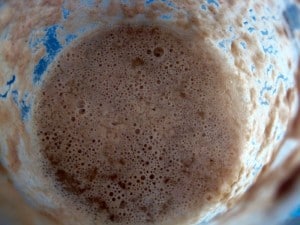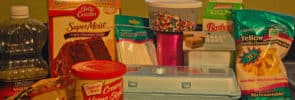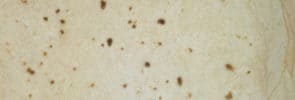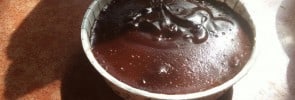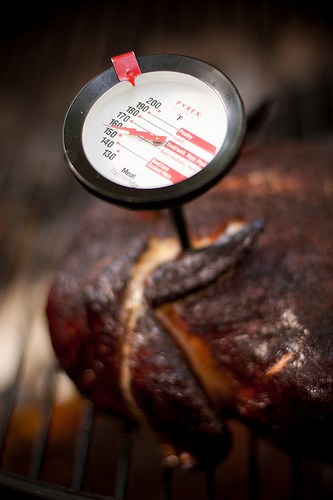This post was originally published on November, 2009 and updated today, April 16, 2020.
Dear readers,
Thanks to the COVID-19 epidemic, people stuck at home have been asking about sourdough. Most sourdough recipes sound quite complicated, but it really isn’t hard to make your own starter. You can then move on to pancakes, muffins, and even bread. My favorite recipes are below, but please feel free to add tried and tested recipes in the comments.
A couple of years ago my baking reached a new level when I began using sourdough. Sourdough encourages the natural yeast spores in the air and flour, encouraging them to multiply in any kind of batter.
Once you have made a sourdough starter from flour and water, you can use it in two different ways:
- Make different types of sourdough bread.
- Add to batter for flavor and a small amount of rising, in pizza dough, muffins, pancakes, and even chocolate cake.
As with any kind of bread (or cooking) there is a bit of a learning curve. If you are used to making bread with commercial yeast, you will notice a few differences. First of all, you need to allow more time for rising. But the timing is more flexible. An extra hour often doesn’t make a noticeable difference. If you are not going to be home when the dough needs attention, you can slow down the process by keeping it in the refrigerator.
Sourdough breads can have different degrees of tanginess, depending on the rising time and other factors. As you experiment you will figure out what you prefer and how long a rising time is required.
Before starting to work with sourdough, you need to prepare the sourdough starter itself. It can take three days to a week or more. If you live in a warm climate or if you generally do a lot of baking, the environment in your kitchen will be more favorable.
While you are making the starter you will need to give it attention every day. After it’s ready, you should try to use and refresh it at least once a week. But I find that mine is still happy after a month.
Please see this post for pictures of the starter at different stages:
Sourdough Starter Stages with Pictures
Sourdough Starter Recipe:
Ingredients
- 1/2 cup water
- 1/2 cup flour. Whole-wheat flour is fine, as are other types like spelt or rye.
- Additional flour and water.
Instructions
- Mix the flour and water in a glass, plastic, or ceramic jar or container. Cover with a cloth to keep out dirt and bugs, but allow air and yeast spores to get in.
- Stir the starter at least once a day. Don’t worry if you miss a day. You might have read that metal spoons should be avoided, but it doesn’t matter.
- After a few days, depending on conditions, you will see tiny bubbles forming inside the mixture. This means the yeast spores are starting to eat the natural sugar in the mixture. (No need to add sugar at any point.)
- Now it’s time to feed the starter. Pour off any liquid on the top and along with half of the starter mixture. Then add another half-cup each of water and flour.*
Update: I no longer pour out any starter, except perhaps the liquid at the top. Just make sure the jar is big enough for the additions. Right now (2020) I’m using a jar from a kilogram of honey, so it holds about a liter or quart. See note below. - Repeat step 4 once a day (more or less) until the starter is ready. It is ready when quite bubbly. You may see a layer of foamy liquid, which eventually settles into an alcoholic-smelling layer of liquid that some people call hooch.
- Now your starter is ready to use in any sourdough recipe! Remember that when you take some off, always add more flour and water in equal amounts, to the original. Switch to a clean container every few weeks (months).
- If your sourdough gets moldy or spoiled (remember that the fermented smell is expected and desired, although not to everyone’s taste), no need to throw it out. Rescue a couple of tablespoons of untainted batter from the bottom and use it to start in a new jar. Any mold will be killed off.
*Why do most recipes recommend throwing out part of the starter? If we want a high proportion of fresh flour compared to the original starter, it would eventually take over the kitchen. But large additions aren’t really necessary.
Sourdough Starter Stages with Pictures
If you have more questions, ask in the comments or check out the Facebook Page for CookingManager.Com. There’s a discussion entitled Sourdough Starter Party. You can also join via the widget on the right sidebar of the blog. That particular discussion has died down but feel free to start it up again.
Thanks to Mimi for comments and corrections on this post.
This post is featured in the Friday Free for All over at Cooking at Cafe D.
Related posts and recipes:
How to Convert Yeast Recipes to Sourdough
Adventures in Rye Sourdough Bread
